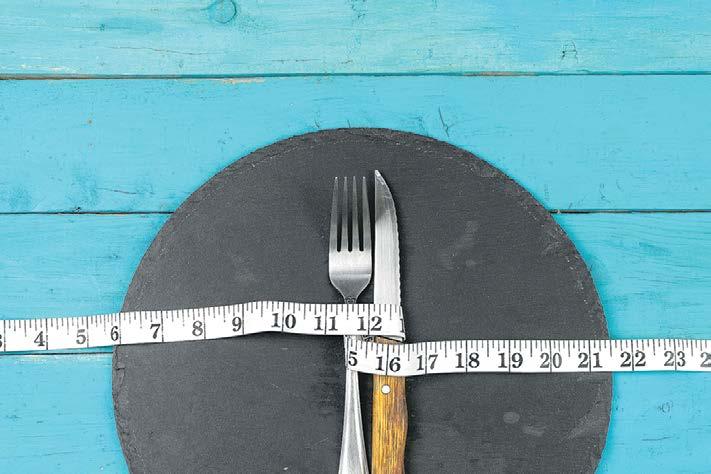
4 minute read
For eating disorders, 'food is the medicine' as Children's Hospital launches feeding clinic
By Leslie Cardé | Contributing Writer
When pop music sensation Karen Carpenter succumbed to anorexia in 1983, she was only 32 years old. She had struggled with an unpublicized eating disorder since she was in high school and died of heart failure after her body, in a constant state of starvation, failed from the physiological stresses put on her organs for a decade and a half.
At 5’4” tall, she weighed 90 pounds when she died and still thought she looked “heavy” in some of her publicity photos. Her death brought awareness to eating disorders and is not dissimilar to the stories of many children and adolescents today in our weight-obsessed culture.
Eating disorders have the highest rate of mortality of all psychiatric diseases. When the pandemic began in March 2020, Children’s Hospital began to notice a big uptick in cases of severe eating disorders in their emergency room.
However, no in-patient facility in Louisiana would admit children or adolescents specifically to treat an eating disorder. Those families went to Houston or Atlanta or Miami until they were stable enough to be released and treated at an outpatient facility closer to home.
Amy Henke, who has a doctorate in psychology and was on staff at Children’s Hospital of New Orleans, wanted those with eating disorders to remain in their homes and still receive bonafide treatments that had a proven record of success.
The result was the first hospitallocated feeding and eating disorder treatment program in Louisiana. It opened in November 2022.
“We use family-based therapy out of Stanford University,” said Henke,
PsyD, a pediatric psychologist at the CHNOLA Feeding and Eating Disorders Clinic.

“The first pillar is weight restoration. We used to think we had to get patients to overcome their psychological issues first and then get them to eat. We now know differently.
“This treatment was developed specifically for adolescents and children. We know that these kids don’t want to eat. So, we get their parents and families involved. Parents must insist that kids eat... so that they serve as an in-patient facility of sorts, like a nurse would at a brick and mortar in-patient facility. Only in this case, the child is monitored from home.”
Enforcing 'consequences'
The clinic at Children’s Hospital includes a dining area, where the patient and the family work together with the psychologist and dietitian to encourage healthy eating. The family is often asked to bring a meal that they think will encourage their child to eat.
“We step in and ask the parents how they might get their child to eat in this moment,” Henke said.
"Then, we start brainstorming. I sometimes ask, what would they do if their child had cancer and didn’t want chemotherapy. What about if they had a broken leg and insisted on running?
"What it comes down to is choosing between life and an eating disorder. If the child chooses the eating disorder, then they’re too medically compromised to have a phone, to go to that dance, to go to their school.
"It’s not about punishing, it’s about making kids understand that there are choices in life, and sometimes there are consequences for the bad choices they make.”
Common eating disorders include anorexia nervosa, where people avoid foods or severely restrict their intake. They are often in denial about the seriousness of their low body weight.
They may have to contend with thinning bones, muscle deterioration, brittle hair and nails, severe constipation and the possibility of multi-organ failure.
Bulimia is a condition where people eat unusually large amounts of food (called binge-eating), followed by forced vomiting, excessive use of diuretics or laxatives, fasting, excessive exercise, or a combination of these behaviors. Purging can have drastic health repercussions.
Eating disorders run in families, and researchers are working to identify DNA variations linked to increased risks. The newest studies have found differences in patterns of brain activity in women with eating disorders compared with healthy women.
While the disorder has traditionally affected women, it’s on the rise in boys and men, thanks in part to social media, where chiseled images on Instagram lure boys with unrealistic expectations.
Social media has had a major effect when it comes to eating disorders, when sadly so much of what’s seen on the internet has been manipulated and edited, while young kids are literally dying to meet these ideals.
WHICH COMES FIRST?
People with eating disorders often have other mental disorders, like anxiety, depression, and even obsessive-compulsive disorder. But which problem incites the other?
“That’s a chicken and egg question,” Henke said. “Is it anxiety initially, then the eating disorder, or the other way around? I can tell you that starvation creates mental health problems. But, anxiety can lead to OCD and eating disorders. So, it’s hard to know which precedes the other.
"There are typical personality styles that are seen with eating disorders. Perfectionists, high achievers, extremely goal-oriented folks, and those in high-pressure settings.”
Once the patient is eating, behavioral therapy can be employed, and in some cases, medications, if indeed there are other co-occurring illnesses, but Henke says there’s no magic bullet.
“It’s an incredibly challenging problem,” Henke said. “Family-based therapy can last anywhere from six to 18 months... But, when anorexia goes on after childhood into adulthood, there is a 1 in 8 death rate, so whatever struggles there are, it’s worth it for the sake of recovery.
"There is no medicine created for eating disorders. Food is the medicine.”
Although most referrals come from pediatricians, if your child has a known eating disorder, you can call the eating disorders clinic directly for an appointment at (504) 896 9827, or email them at cheatingdisordersclinic@LCMChealth. org.
--- Leslie Cardé









